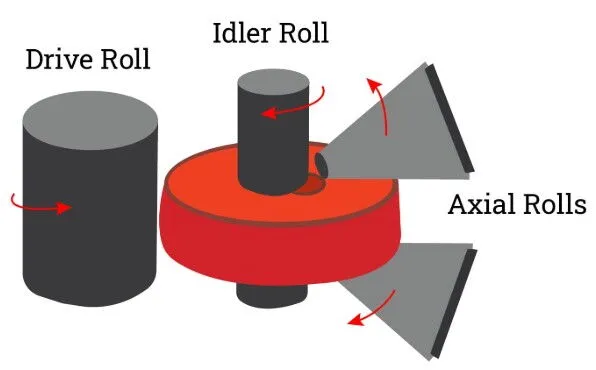Ring rolling, also known as ring expanding, is a crucial process for manufacturing ring forgings. It involves rolling a ring-shaped blank on a specialized ring rolling machine using rotating dies to simultaneously expand the inner and outer diameters of the blank while reducing the wall thickness, thereby forming the desired ring forging. This process is not only suitable for mass production but also enhances production efficiency and machining accuracy. Below, we will provide a detailed introduction to the characteristics, applications, and different types of ring rolling technologies.

Basic Characteristics of Ring Rolling
The ring rolling process offers a series of unique advantages, making it a significant technique in the forging industry.
Continuous Deformation with Small Reduction: The ring rolling process involves the rotational deformation of the blank on the ring rolling machine with a small reduction. The continuous deformation ensures high precision of the workpiece while avoiding adverse effects caused by excessive deformation.
Surface Deformation: The ring rolling process not only achieves uniform deformation but also maintains the smoothness of the workpiece surface, ensuring excellent surface quality of the forgings.
High Production Efficiency: Compared to free forging, the production efficiency of ring rolling can be increased by approximately 30%. Due to its simple equipment structure, low cost, low noise, minimal vibration, and excellent working environment, ring rolling has become a highly popular manufacturing method.
Superior Dimensional Accuracy: Ring forgings produced by ring rolling exhibit better dimensional accuracy than those produced by free forging. The diameter tolerance is one-third to one-half that of free forgings, with smaller surface roughness, wall thickness errors, and roundness errors.
Advantages of Ring Rolling
The ring rolling process not only improves material utilization but also enhances product quality. Specific advantages are as follows.
Increased Material Utilization: Material utilization can be improved by 10% to 20% through ring rolling. Additionally, the uniform wall thickness and circumferential distribution of metal flow lines prevent the breakage of metal fibers, thereby improving the mechanical properties of the forgings.
Reduced Machining Time: The ring rolling process can significantly reduce subsequent machining time, typically by 15% to 25%, which not only lowers production costs but also improves production efficiency.
Improved Metal Structure: During ring rolling, metal flow lines are uniformly distributed along the circumference, avoiding local over-compression or over-stretching, which helps improve the metal structure and performance of the forgings.
Reduced Labor Intensity: The ring rolling process not only enhances production efficiency but also creates a more relaxed working environment, reducing labor intensity and facilitating mechanization and automation of production.
Adaptability and Production Range of Ring Rolling
The ring rolling process is highly adaptable and can be adjusted to meet different production needs. The production range of ring forgings can vary from a few millimeters to 10 meters in diameter, with virtually no limitations. As a result, ring rolling is widely used in industries such as aerospace, energy, automotive, chemical, and shipbuilding.
Mass Production: The ring rolling process is particularly suitable for mass production, improving efficiency and reducing costs.
Material Diversity: This process can be applied to various metal materials, including carbon steel, alloy steel, and stainless steel.
Finished Products or Blanks: Ring rolling can produce finished ring forgings or provide blanks for other forging processes, further expanding its application scope.
Classification of Ring Rolling Processes
Based on the deformation method and equipment design, ring rolling processes can be classified into several types, each suited to different production requirements.
1. Radial Ring Rolling
In radial ring rolling, the radial direction of the ring blank is compressed, causing the metal to expand tangentially with minimal axial change. This process is mainly suitable for ring forgings with rectangular, grooved, or cross-shaped sections. Radial ring rolling uses simple equipment with low costs, making it widely applicable in production.
Equipment Types: For ring forgings with outer diameters of less than 1000mm, vertical ring rolling equipment is typically used, while horizontal structures are used for larger diameters.
2. Radial-Axial Ring Rolling
Radial-axial ring rolling adds end-face rollers to the radial ring rolling process, allowing simultaneous axial and radial deformation. This process is particularly suitable for ring forgings with large wall thicknesses or complex cross-sections, enabling the production of rings with flat end faces. Compared to traditional radial ring rolling, this process significantly reduces the frequency of mold changes, thereby lowering production costs.
Mold Lifespan: The reduced frequency of mold changes effectively decreases material loss during production.
3. Open-Die and Closed-Die Ring Rolling
Ring rolling processes can also be classified based on the form of the groove on the ring rolling machine.
Open-Die Ring Rolling
This process uses flat rollers and is suitable for expanding large rectangular cross-section rings. The advantage of open-die ring rolling is that the same pair of rollers can process rings of different sizes. However, due to the tendency for uneven deformation, conical forging is often required to precisely control the height of the blank.
Closed-Die Ring Rolling
Closed-die ring rolling uses specially designed roller grooves based on the cross-sectional shape of the workpiece, making it suitable for forming ring forgings of various shapes. This process offers high precision and is ideal for manufacturing complex ring forgings.
Applications of Ring Rolling
The advantages of ring rolling make it widely applicable in various industries, particularly in the manufacturing of high-precision, high-strength ring forgings. Key application areas include:
Aerospace: Ring rolling is used to manufacture high-strength, high-precision ring forgings for aircraft engine components and structural parts.
Energy Industry: Examples include the production of large heat exchangers, valves, and pipelines.
Automotive Industry: Ring rolling is used to manufacture automotive engine parts, gears, and wheels.
Chemical and Shipbuilding Industries: Ring rolling is employed to produce various precision pipe connectors, containers, and pipeline fittings.
Conclusion
As an efficient method for forming ring forgings, the ring rolling process has become an indispensable core technology in the forging industry due to its high production efficiency, superior precision, and strong adaptability. Whether it is improving material utilization and reducing production costs in mass production or ensuring precision in the manufacturing of complex ring forgings, ring rolling plays a vital role. With technological advancements, the application of ring rolling will continue to expand across industries, driving efficient and precise manufacturing.

